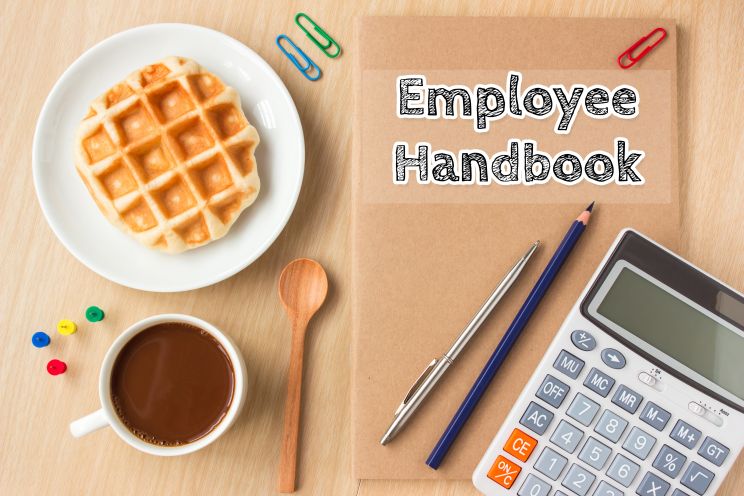The Employee Handbook
An employee handbook is a useful tool for companies of all sizes. Business owners tend to think of a handbook as necessary as the company becomes larger, but organizations should institute policies and processes as soon as they start hiring employees. This document can help employees understand the culture of the company before they start working there as well as the behavioral expectations of the company.
What is an employee handbook?
An employee handbook can take many forms. In some companies, it includes all policies, procedures, and protocols of the organization. In other companies, it describes the HR policies that impact the employee lifecycle.
For example, it may detail procedures like performance reviews and the process to call in sick. It may also describe the benefits available to employees such as health benefits, work from home options, and vacation time.
The goal of a handbook is to (1) set expectations for employees, and (2) increase employee engagement through strategic HR management.
The handbook is also a good place to build employee engagement. This is done through the mission and vision statements of the organization, which should be stated at the beginning of the document. These statements ground the employees in the goals and objectives of the company.
The handbook also may contain some legal information. Although federal and state laws do not require employers to provide a handbook, this is a great way to get information to employees in a consistent and timely manner.
Employers should check to see if there are any legal requirements within their state as to what information must be provided to employees. For example, in California employers must make their employees aware of Paid Sick Leave and other required leaves available.
Benefits
The biggest benefit of a handbook is that you have a document to help employees through the first few days of employment. This is a time when employees are unsure of what they can expect.
A handbook details many of the processes that impact the employees on a personal level. For example, a handbook may detail how a disciplinary action takes place. While most people do not like to think about things that can go wrong over the course of their employment, it is useful for managers to set expectations.
An employee handbook is one way that companies can disseminate information to employees. It is a good idea to have employees acknowledge they have read the handbook by signing it, which can be done on paper or electronically.
This also serves strategic HR management procedures. If an employee were to challenge the company regarding one of the procedures, having the employee acknowledgment that they have read the policy can help the company mitigate the challenge. Of course, you should speak with the company’s legal counsel about how to reduce risk through handbooks.
When should a company create a handbook?
Companies of all sizes can benefit from a handbook. A written document can help set expectations for employees, which can help in conflict resolution. Employees who feel like they are being treated fairly are more likely to feel engaged at work.
However, it is important to understand that once you have a written procedure, you must treat employees in similar situations in a similar manner. That does not mean you need to follow the handbook exactly in all circumstances; situations may arise that are unique and require a unique approach.
However, the management team should be prepared to follow the handbook for the vast majority of situations.
It is important that companies that create an employee handbook have their legal counsel review it before it is published. Ideally, this should be reviewed by a lawyer who is familiar with employment law specifically, not just business law.
What to include in an employee handbook
Employees’ handbooks are unique to the culture of the company and should not just be a copy and paste of what is publicly available. The handbook creates a unique opportunity to set the tone for new employees as they begin to integrate with the company. Below are some things that may be included in a handbook:
- Company mission and vision
- Attendance policy
- Dress code
- Anti-harassment policy – this should include sexual harassment as well as harassment on the basis of any protected class characteristics. Protected class characteristics include age, sex, disability, race/color, national origin, and religion. This is not an exhaustive list and some states and cities include more protected class characteristics.
- PTO and how to request time off (both sick time and vacation time)
- Performance management
- Disciplinary policies
- Safety procedures (including OSHA requirements)
- Anything else relevant to the company
Most companies in the United States also include a statement that employment is at-will. You should consult with your legal counsel to ensure that the handbook does not create a contract between the company and employees.
Handbooks should be reviewed on a yearly basis. While most of the material is often the same, you should consider the company goals and objectives on an annual basis and update the handbook based on that. Also, there may be changes in the legislative environment that may impact employee policies.
For example, in 2018 there were new laws introduced in Massachusetts that strengthened equal pay for equal work. There were also changes to questions about salary history for job applicants. Handbooks should be updated to reflect the new realities in the states in which companies operate.
An employee handbook is a document you want employees to read and refer to. Where possible, simplicity is key. The document can be graphically appealing or it can be in the form of a presentation.
Either way, it should be easy to understand and a document that they can easily read. This document sets expectations for employees and helps the company disseminate information to employees.
Call us. We are here to help.
Monday – Friday: 8:30 am – 5:30 pm (516) 599-2120 or Info@VantagePointBenefit.com


